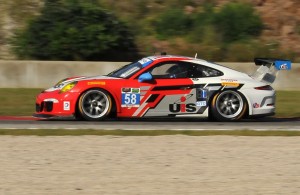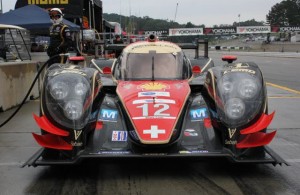Sebring Memories – 1987
- Updated: March 13, 2012
After our experience at the 12 Hours of Sebring in 1986 with our Porsche Fabcar, we returned again in 1987 to try again. Only this time, we came armed with much more experience, a lot more spares and even a second car.
Tim McAdam had commissioned Dave Klym to build a second Porsche Fabcar, and we brought it along with the original car to Sebring in 1987. The driver line up for the team was to be John Higgins, Howard Cherry and Dr. Charlie Monk in the original car (#42) and Chip Mead, Scott Overby and Tim McAdam in the new car (#43).
Before getting into the Sebring story, first a little background on the beginning of the 1987 season for us.
We came to the 24 Hours of Daytona with both cars and had applied pretty much all of the lessons we learned from our experiences in the 1986 season. The nose box on the car was now reinforced with new metal straps to keep the downforce from pulling the nose and nosebox off of the car and we made some really substantial improvements to the electrical system.
In doing some research before Daytona we determined that the most likely reason for a car to experience problems during a long endurance race was electrical, and most often these problems started to show up after the car had run for seven or eight hours. So in the off season we made some really dramatic changes to the electrical system on the original Fabcar chassis to try and anticipate these problems before they became an issue in the race.
We eliminated the original Porsche alternator which was driven directly off of the engine, and that had the added benefit of increasing the horsepower to the drive train since it didn’t have to spin a massive alternator all the time. In its place, we installed two VW alternators (right off of a VW Jetta!) that were driven directly off of the rear axles of the car, one on each side. We installed a switch in the cockpit for the drivers to switch from alternator “a” to “b” should a charging problem arise. In our tests, as long as the car was traveling faster than about 50 MPH, the alternators would spin fast enough to provide a charge for the electrical system.
In addition to the dual alternator set up, we also installed a second battery that was tied into the second alternator, so if there were battery problems, again the problem could be cured with the flip of a switch.
All of these improvements were put to good use at the 24 Hours of Daytona, where after a very strong run, the #42 car finished 2nd in the Lights Class, and would have won easily but for a broken axle late in the race. The breakage was caused by getting one wheel over-spinning in the pits after traveling through a puddle of water left by another disabled car. Such is racing.
After Daytona we went to Miami, where Chip Mead and Charlie Monk combined for the team’s first class victory. Again, the car preformed perfectly and we were quite excited about our prospects for Sebring, having started a 2nd and a 1st in the first two races of the season.
The 1987 Sebring featured 9 GTP prototypes, 20 GTP Lights (including our 2 Fabcars), and the balance of the 74 car grid was filled with GTO and GTU entries.
The Porsche Fabcars qualified mid-field, a good 5 seconds plus behind the factory Spice Fieros which would dominate the first half of the race.
Our plan: go as quickly as possible without getting into trouble on the track, work the yellow caution periods to gain an advantage and most of all, stay on the track and out of the pits.
The race started and everything was going to plan. The #42 car ran steadily and continued to move up through the field as other Lights class cars experienced problems and fell back. The #43 car was not so fortunate, as it experienced some of the new car teething problems that we had with the #42 car the year before, but they kept working on small issues and continued as well.
Ray Thacker and I worked on pit strategy and were able to gain track position and actually move up through the field by taking full advantage of the multiple full course cautions during the race. By keeping close track of our position on the track in relationship to the overall leader, we timed our pit stops so that we were able to gain a lap on our competitors a number of times. As long as we were positioned on the track ahead of the overall leader, but behind the pace car, we would get waved around before the course went green again, giving us the opportunity to literally get a free lap. This was no small task back in 1987, as we had no computers, no live telemetry – just stopwatches, lap charts and our constant observation of what was going on in front of us on the track.
Another thing of note about this race which was quite memorable – there were no pit speed limits in 1987. The pits were actually considered a part of the racing surface, and cars were allowed to pass one another in pit lane, at full speed.
My job during pit stops was to signal the car to our pit box, connect the air hose to raise the car on the jacks, clean the windscreen and after all the work was done, signal the car out of the pit box and back onto the track.
Signaling in and signaling out was the most stressful part of this job, as with no pit road speed limit, cars were coming and going so quickly you had to be on top of your game all of the time, or regardless of how well things were going on the track, your race could end quite quickly with a pit road incident.
Once you told the driver to go, his job to was rev that sucker up, dump the clutch and get the hell out of there as quickly as possible. Looking back, it was amazing how dangerous the pit lane was during the race and I can see why pit lane speed limits were later instituted. At the time, however, that is just the way it was.
By mid-race the #42 Fabcar of Higgins, Monk and Cherry had moved into first place in the Lights Class. By sunset, we were still in first place. With a couple of hours left, we were not only in first place, but leading by over 4 laps.
Charlie Monk, a doctor from Canada and both a great guy and quite a fast driver, was behind the wheel of our leading Porsche Fabcar with about an hour to go in the race. We elected to keep him in the car after our last pit stop for the finish, as we had been in radio contact with him and he said he was doing fine and he was running good, consistent and steady laps.
Naturally, then the radio went out. On the track, somewhere out there in the darkness, the Ball Brothers Racing Pontiac Fiero GTP passed Charlie. Now, apparently, Charlie got it into his head that he had just been passed for the lead. He started driving like a man possessed. He went faster and faster each lap, actually lapping faster than our qualifying time.
In the pits, John Higgins was going nuts. He had been trying to win this race for years, and here we were, less than an hour away from what seemed like a sure victory, and Monk was out on the track driving like Gilles Villeneuve.
With every passing lap Monk showed no signs of slowing down, even though we were frantically waving our pit sign as he drove by each lap with “P1 – EZ”. Monk just kept up his charge, trying to chase down that elusive Pontiac Fiero which was actually running in 3rd place in Lights, 6 laps behind us!
Finally, mercifully, the 1987 12 Hours of Sebring ended before anything bad happened and the #42 Porsche Fabcar of Higgins, Monk and Cherry won the GTP Lights Class, covering 267 laps and finishing a full 6 laps ahead of the second place car in the class.
And Charlie Monk? After he came to a stop on the front straight by the start finish line, he was so exhausted by his flat out double stint that we had to lift him out of the car. His first question was “Where did we finish?”
Looking at the car, it became obvious why he hadn’t responded to our frantic pit signals, for in addition to the radio being out, the windscreen of the Fabcar was totally streaked and smeared with dirt and oil from that last desperate race to the finish.
It was a perfect Sebring for us. The winning #42 car spent less than 11 minutes in the pits during entire race and didn’t make a single unscheduled pit stop nor experience a single mechanical glitch during the entire race (except for the radio failure).
For everyone on the team, nothing in racing, and I do mean nothing, could ever top the feeling of coming to Sebring and winning. To everyone who has ever raced there, they know exactly what I am talking about.
Happy 60th Anniversary Sebring – There are many more fond memories just waiting to happen in your future.
Jack Webster has been shooting motorsports since the early 1970’s, covering Formula One, CanAm, F5000, TransAm, GrandAm and American Le Mans races, among others. In addition to his photography, he has also worked on racing teams, both in IMSA and IndyCar, so has a complete knowledge of the inner workings of motorsport. Both his photography and writing can be seen here on racingnation.com


![Rain tire. [Jack Webster Photo]](https://racingnation.com/wp-content/uploads/2015/10/151003PetitraintireDSC04384-300x195.jpg)



![Porsche Fabcar crosses the finish line. [Robert Madara photo]](https://racingnation.com/wp-content/uploads/2023/11/FabcarFinish-108x70.jpeg)

![USF2000 Pro driver Lindsay Brewer. [Eddie LePine Photo]](https://racingnation.com/wp-content/uploads/2023/06/IMG_8825_2-108x70.jpg)